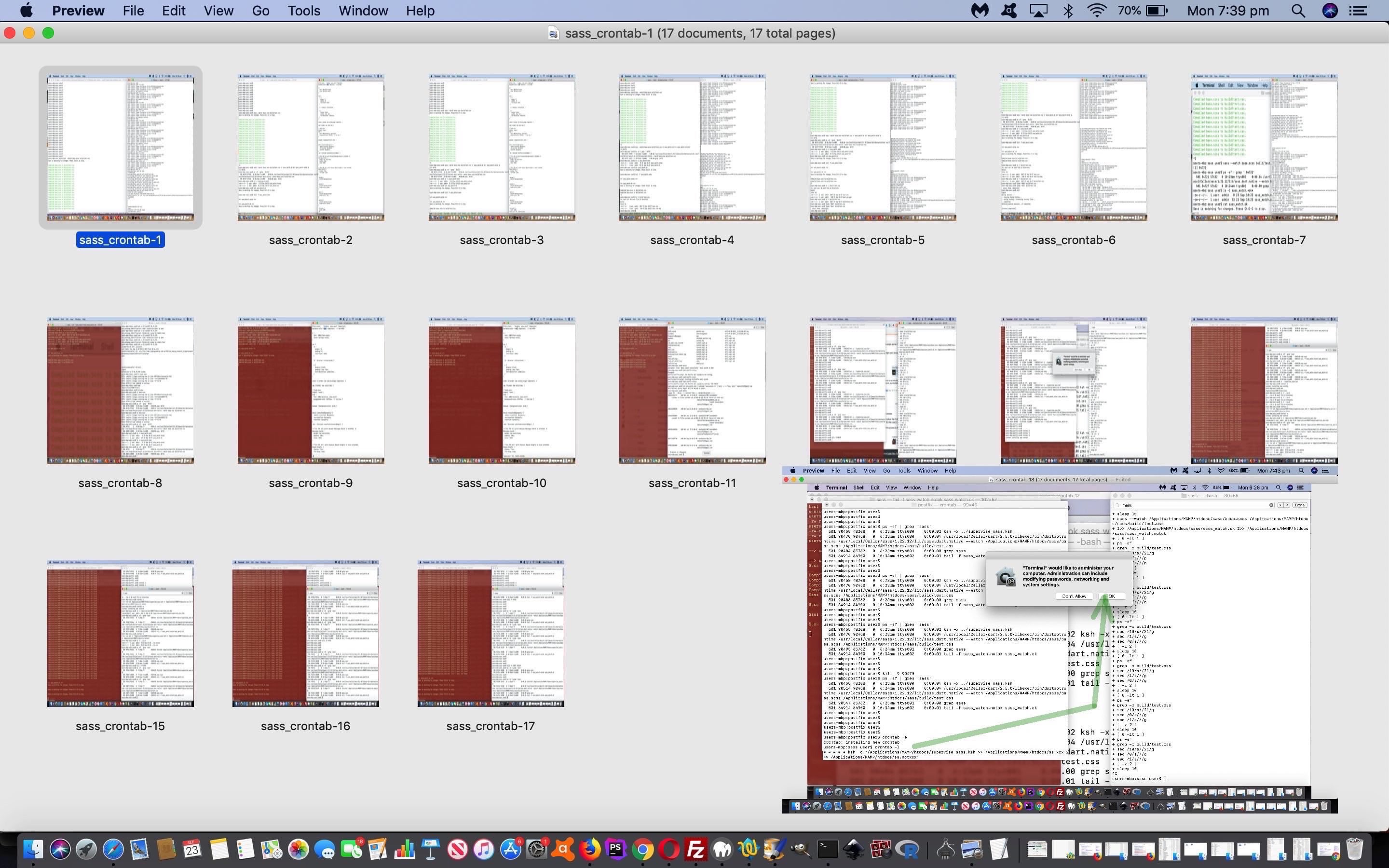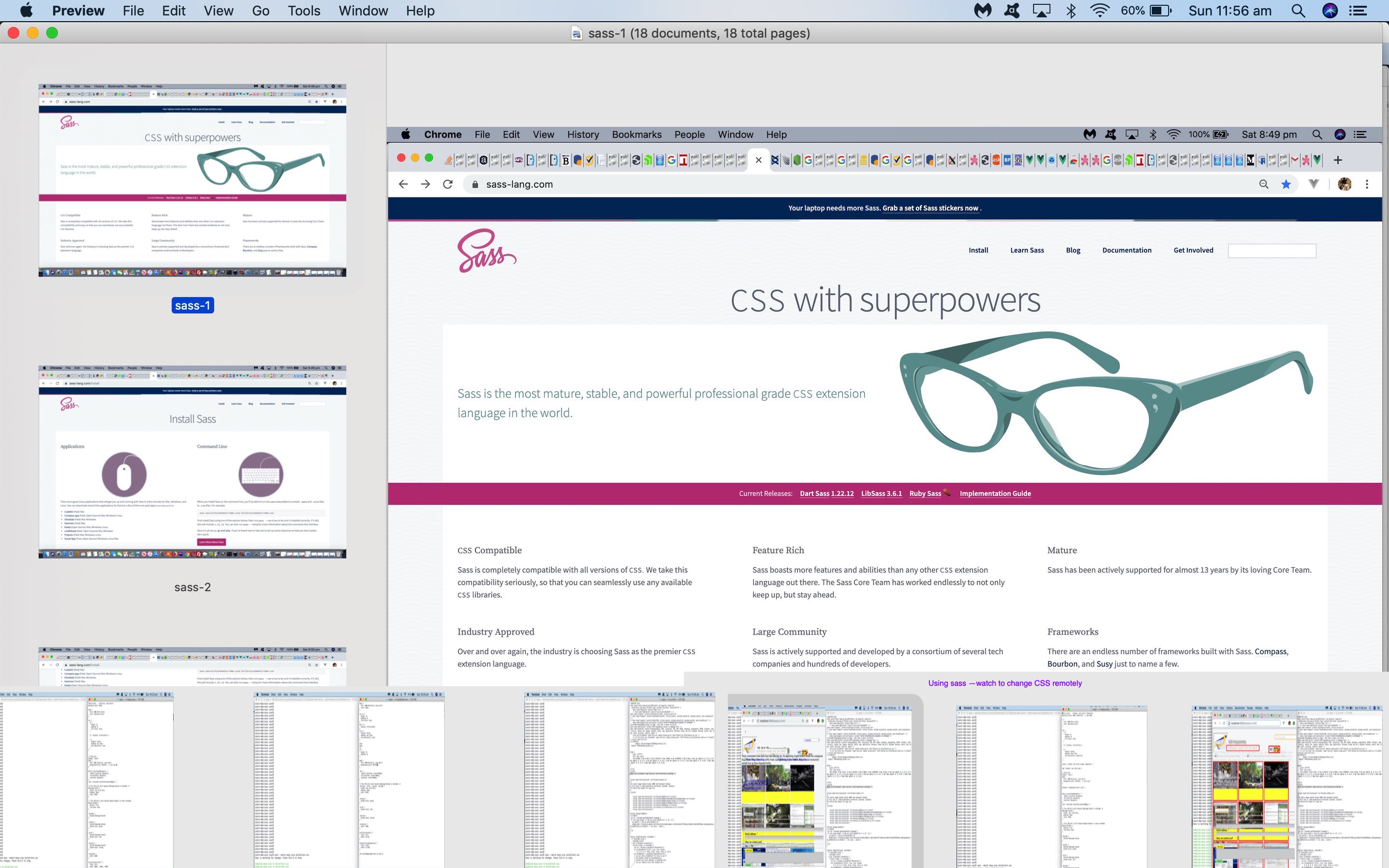Yesterday’s Sass CSS Stylesheet Primer Tutorial showed a really promising procedural CSS stylesheet creator tool …
sass --watch [inputSassSCSS] [outputCSS]
… in action, but the mode of that procedural application of that …
- sass –watch [inputSassSCSS] [outputCSS] # in a Mac OS X (or macOS) terminal window command line … held up the further use of that window, because it is a foreground process … and so jarred with us … but today’s work, good for Linux and/or Mac OS X (or macOS) … and which you can see in action with today’s PDF slideshow … allows for …
- Linux or Mac OS X (or macOS) …
- sass –watch [inputSassSCSS] [outputCSS] & # in a Mac OS X (or macOS) terminal window command line run as a background process that remains even after logout, which is mostly all you need, except that “sass –watch” process can fallover … so …
- crontab controlled Sass “watchdog” (remember Linux Watchdog Primer Tutorial) … that checks on whether Sass “watchdog” is running, and whether a (CSS stylesheet) file set check instance execution is running …
#!/bin/ksh
# supervise_sass.ksh
# RJM Programming
# Make sure "sass --watch base.scss build/test.css" is running
if [ -z "`ps -ef | grep -v 'grep' | grep -c 'supervise_sass.ksh' | sed '/10/s//21/g' | sed '/1/s///g' | sed '/0/s///g'`" ]; then
while [ 0 -lt 1 ]; do
if [ -z "`ps -ef | grep -c 'build/test.css' | sed '/10/s//21/g' | sed '/1/s///g' | sed '/0/s///g'`" ]; then
/usr/local/Cellar/sass/1.22.12/bin/sass --watch /Applications/MAMP/htdocs/sass/base.scss /Applications/MAMP/htdocs/sass/build/test.css >> /Applications/MAMP/htdocs/sass/sass_watch.ok 2>> /Applications/MAMP/htdocs/sass/sass_watch.notok &
fi
sleep 10
done
fi
exit
… (a Sass “watchdog”) called supervise_sass.ksh … via … crontab -l …
* * * * * ksh -c "/Applications/MAMP/htdocs/supervise_sass.ksh >> /Applications/MAMP/htdocs/ss.xxx 2>> /Applications/MAMP/htdocs/ss.notxxx"
… and note how what “sass” represents (in commands) needed to be written in “longhand path terms” in crontab land, because you should not assume anything about the environment associated with crontab
… which is good now “for leave it (ie. Sass CSS Stylesheet preprocessing) to look after itself, and resurrect itself”. But tomorrow we want more genericity regarding …
- more Windows friendly aspects to “watchdog” talk
- allow for multiple (CSS stylesheet) file set arrangements … but also (a more thorough “watchdog” should) …
- allow for a “complete shutdown, and not resurrect” mode of use
Previous relevant Sass CSS Stylesheet Primer Tutorial is shown below.
When compartmentalizing web design work, and you’ve already done a compartmentalization to …
- backend – (ie. “the data”, “the configuration”) … and …
- frontend – (ie. “the look”, “the functionality”)
… a very natural, and intuitive way to divvy up some of the tasks for “frontend” above, a programmer or developer or team could work on …
CSS styling
… both in a …
- project wide CSS styling sense … and into …
- nuances for exceptional webpages, perhaps
… and it is here that we think today’s (“Hello World”-ish) trial of the Sass (“Syntactically Awesome Style Sheets”) command line product should be of interest for you.
Let’s list in broad brush terms what Sass is capable of as far as CSS styling goes, and which we show you a stream of consciousness view of with today’s PDF slideshow presentation (showing you an install on a MacBook Pro, and showing its features, and the mock up of a Sass *.scss file along with its imagined “sass –watch” manipulation to change the look of a mockup webpage) …
- ability to preprocess, facilitating that compartmentalization thought above, command line “sass –watch” option can have a developer working on CSS stylesheet files (separately to other developers working on HTML (or server developers on PHP), separately to other developers working on Javascript) that are not the live CSS files, one step removed via “sass” looking out for changes and automatically building the live CSS files when Sass *.scss files are saved … as well as syntax and cross-browser thoughts such as …
- ability to include snippets (“partials”) or import from other Sass *.scss stylesheet files
- ability to have Sass variables
- ability to handle Sass nesting syntax
- ability to include Sass mixins to help with those cross-browser prefix (eg. “-webkit-“, “-ms-“) directive complications
- ability to share Sass (CSS) properties from one selector to another (“extend/inherit”)
- ability to do mathematics via Sass “operators” helping convert hard-coded dimensions in pixels (px) to percentage (%) values better for responsive design principles
We hope you try out this wonderful software tool for yourself.
If this was interesting you may be interested in this too.
If this was interesting you may be interested in this too.




